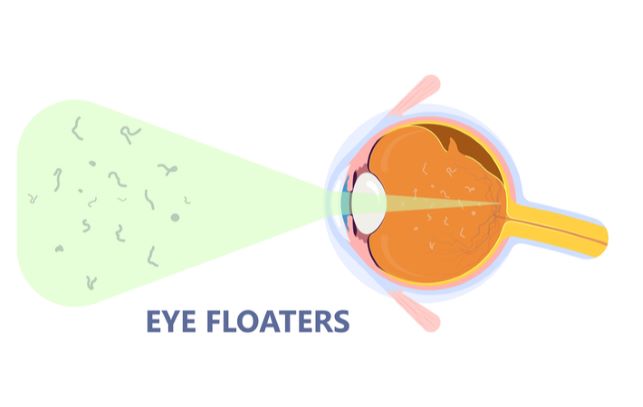Eye floaters and flashes are common visual problems that many people experience in their daily lives. While they can certainly be annoying, in most cases, floaters and flashes are not harmful to your visual health. In some cases though where floaters and flashes are numerous and obstructive, it could require emergency eye care or eye disease management.
If you are uncertain about if eye floaters and flashes are damaging your visual health, or are unsure of their cause, please do not hesitate to contact The Eye Gallery for an eye examination. Our eye doctors will be able to recommend the most effective course of action to help you deal with eye floaters and flashes.
What are Eye Floaters?
Eye floaters can be described as “spots” in your vision. They may appear as black or grey specks, strings, or web-like shapes that drift around your vision when you move your eyes around. Most eye floaters are caused by age-related changes as the vitreous (the white, jelly-like substance that fills your eyeballs) of your eyes becomes more liquified. Microscopic fibers in the vitreous can start to clump together and cast small shadows on your retina, appearing as eye floaters.
Eye floaters are typically not dangerous, but if you notice a significant amount of them accompanied by eye flashes and a loss in peripheral vision, it is important to contact The Eye Gallery right away for emergency eye care.
What Causes Eye Floaters?
Eye floaters usually become apparent due to the normal aging process, but can also be the result of other diseases or conditions. Eye floaters can be caused by:
- Age-related eye changes — The vitreous begins to liquefy as you age, causing it to recede from your eyeball’s interior surface and enable fibers to clump together, which will appear as floaters.
- Inflammation in the back of the eye — Posterior uveitis is a condition in which inflammation occurs in the layers of the uvea in the back of the eye. The release of debris into the vitreous caused by this condition can emerge as floaters in your eye.
- Bleeding in the eye — Blood cells can be seen as floaters if they make their way into the vitreous. Bleeding into the vitreous can have many different causes.
- Torn retina — Retinal tears can start to occur if a sagging vitreous begins to tug on the retina. Without proper treatment, a retinal tear can lead to retinal detachment.
- Eye surgeries and eye medications — Some medications that are injected into the vitreous and certain eye surgeries can indirectly cause air bubbles to form, which can be seen as floaters in your eye.
Symptoms of Eye Floaters
Symptoms of eye floaters may include:
- Small shapes in your vision that appear as black or grey specks, strings, or web-like shapes of floating material.
- Spots that move when you move your eyes.
- Seeing spots when you look at a plain, bright background.
- Shapes or strings that eventually stop moving and drift out of your direct visual field.

What Are Eye Flashes?
Eye flashes are spots of light that you can see in your visual field. The most common way to describe the symptoms of eye flashes is to liken them to “seeing stars” or streaks of lightning. Eye flashes are not caused by external light sources; they actually occur inside of your eye.
Flashes of light in your eyes typically occur and fade very quickly. If the light is sustained for a while in your visual field, it may be an indication that the flashes are being caused by a migraine. Migraine “aura” can look like a shimmering, wavy line in your visual field, and can appear even if you do not currently have a headache.
What Causes Eye Flashes?
These are some conditions that can cause eye flashes:
- Choroidal Neovascular Membranes
- Cytomegalovirus Retinitis
- Detached and Torn Retina
- Histoplasmosis
- HIV/AIDS
- Migraine
- Posterior Vitreous Detachment
- Stickler Syndrome
- Vitreomacular Traction
Treating Floaters and Flashes
Most times, eye floaters and flashes will not cause your vision significant damage and will go away on their own. Some more serious cases exist though, and you should contact The Eye Gallery right away if:
- You notice a lot of new floaters have started to become visible in your visual field in a short amount of time.
- You have a lot of eye flashes — enough to warrant concern or disrupt your daily activities.
- Shadows often appear in your peripheral vision.
- A black or grey opaque shroud starts to cover a part of your vision.




